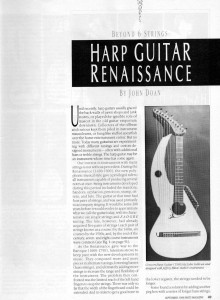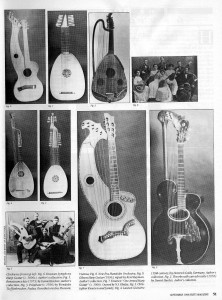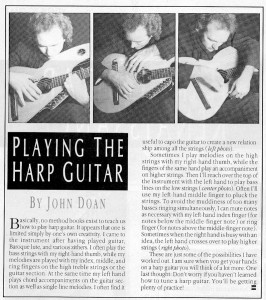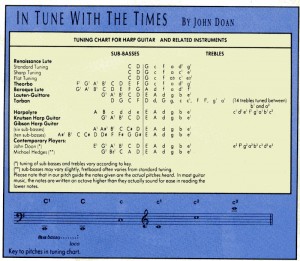by John Doan, published originally in the September 1988 issue of Frets magazine
 Until recently, harp guitars usually graced the back walls of pawn shops and junk stores, or played the ignoble role of mascot in the old guitar emporium downtown. Collectors of the offbeat and curious kept them piled in instrument mausoleums, or hung like stuffed spearfish over the home entertainment center, but no more. Today many guitarists are experimenting with different tunings and custom-designed instruments–often with additional bass or treble strings. The harp guitar may be an instrument whose time has come again.
Until recently, harp guitars usually graced the back walls of pawn shops and junk stores, or played the ignoble role of mascot in the old guitar emporium downtown. Collectors of the offbeat and curious kept them piled in instrument mausoleums, or hung like stuffed spearfish over the home entertainment center, but no more. Today many guitarists are experimenting with different tunings and custom-designed instruments–often with additional bass or treble strings. The harp guitar may be an instrument whose time has come again.
Predecessors to the Harp Guitar
 Our interest in instruments with many strings is not without precedent. During the Renaissance (1400-1600), the new polyphonic musical style gave a privileged role to all instruments capable of producing several notes at once. String instruments developed during this period included the mandora, bandora, orpharion, penorcon, stump, cittern, and lute. The guitar at that time had four pairs of strings, and was used primarily to accompany singing. It would be some 200 years before it would evolve to approximate what we call the guitar today, with its characteristic six single strings and EADGBE tuning. The lute, however, had already acquired five pairs of strings (each pair of strings known as a course) by the 1400s, six courses by the 1500s, and, by the end of the century, seven- and eight-course instruments were common.
Our interest in instruments with many strings is not without precedent. During the Renaissance (1400-1600), the new polyphonic musical style gave a privileged role to all instruments capable of producing several notes at once. String instruments developed during this period included the mandora, bandora, orpharion, penorcon, stump, cittern, and lute. The guitar at that time had four pairs of strings, and was used primarily to accompany singing. It would be some 200 years before it would evolve to approximate what we call the guitar today, with its characteristic six single strings and EADGBE tuning. The lute, however, had already acquired five pairs of strings (each pair of strings known as a course) by the 1400s, six courses by the 1500s, and, by the end of the century, seven- and eight-course instruments were common.
As the Renaissance gave way to the Baroque (1600-1750), lutenists strove to keep pace with the new developments in music. They composed more and more pieces in alternate tunings, lowering basses (bass strings), and ultimately adding more strings to increase the range and flexibility of the instrument. The problem they confronted was the limited reach of the left-hand fingers to stop the strings. There was only so far that the width of the fingerboard could be extended. And in order to get a good tone in the lower register, the strings needed to be longer.
Some found a solution by adding another peg box with a series of longer bass strings, tuned in a descending diatonic scale. This enabled them to avoid using left-hand fingering: Only the right-hand thumb was required to pluck the open bass strings. The resulting large Theorbo, and still larger chitarrone, often had six double courses with eight single bass strings. Others went to more of an extreme to develop the Poliphant, an instrument with a harp-like frame supporting 20 basses and 15 diatonic trebles, and an ordinary lute in the middle.
The lute had experienced a golden age, when its finest music was composed and performed by the likes of John Dowland (1562-1626). But it gradually fell out of fashion in favor of the Baroque keyboard instruments. Almost doomed to obscurity, the lute ventured into the seventeenth century in a diminished capacity. It remained in use throughout Europe by virtue of its ability to be intimate, portable. and complementary to the voice. It developed a new standard tuning, and commonly had between 11 and 14 courses (up to 28 strings). By the eighteenth century the lute was all but abandoned, except in Germanic countries. Whatever may have been lost to a diminishing sphere of activity was more than made up for in the quality of the compositions left by J.S. Bach (1685- 1750), S.L. Weiss (1686-1750), and numerous others.
The First Harp Guitars
The first so-called harp guitar (it actually was an 8-string guitar with a triangular body) appeared about 1798, built by Edward Light of London. Later he developed a harp-lute guitar which had an extra peghead with four bass strings. But even earlier (1773), a harp maker in Paris named Naderman had built a true harp guitar with six standard fretted strings and six bass strings. He called it a “bissex,” meaning “double six” (although Jay Leno may have another theory to its meaning).
In the nineteenth century, the 6-string guitar became more popular in amateur circles, and gained some measure of respectability in the hands of Fernando Sor (1778-1839), Mauro Giuliani (1781-1829), and Matteo Carcassi (1792-1853). With the rise of a new style of music, much experimentation occurred in the design of the guitar, as it had earlier with the lute. In addition to exploring various string lengths, body sizes, and bracing configurations, instrument builders came up with entirely new creations. They included the lyre guitar, arpeggione, diplo kithara, dital harp, guitare decacorde, guitarpa, and harpolyre. Guitar virtuosi such as Sor and Carcassi were so impressed with the harpolyre’s three necks, 21 strings, and greater volume, that they each composed several pieces for it. Napoleon Coste (1805-1883), a student of Sor, performed on several multi-string guitars, as did J.K. Mertz (1806-1856) and Adam Darr (1811-1866).
Toward the end of the century, it became quite popular to play instruments called bass guitars, which had from four to nine additional bass strings. Guitarists such as N.P. Makarov (1810-1890), V.P. Lebedev (1867-1907), and M.K. Sokolowski (1818-1883) were trying to meet the contemporary demand for fuller, deeper resonance, greater volume, and more flexibility to accommodate the many key modulations that were so easily achieved on the piano. (The keyboard strikes again!)
Meanwhile, the lute held out in its last strongholds in German-speaking countries and eventually attached itself to the Wandervögel movement of the late nineteenth century becoming the symbol for a return to nature and simpler times in reaction to the excesses of growing industry and large cities. It became a folk instrument with six single strings tuned like a modern guitar. It still had the appearance of the lute, and many instruments retained the additional basses. Because of this overlapping with the guitar they became known as lauten-guitarre (lute-like guitars), or lutars (those who are not fond of this instrument call them “gututes”).
Another popular instrument of this time was the torban, a Polish and Ukrainian instrument with six pairs of strings affixed to a main peg box, four single offboard strings to another peg box, and 14 or 15 more strings stretched over the treble side of the body. Harp guitar-like instruments still are being played in Eastern Europe: Witness the bandoura of the Ukraine, with 30 strings– eight attached to tuning pins on the neck, the others to pins around the edge of the body.
The Harp Guitar in America
The harp guitar first appeared in the United States around the 1880s. One of the earliest important makers was Christopher Knutsen of Port Townsend, Washington. He claimed to be the “sole patentee” of the “One-Armed Harp Guitar” and even went on to claim on the inside label, “this is the deepest toned instrument made.”; In addition to the “one arm” design, his instruments had five sub-basses, often slanted frets (Knutsen Harp Guitar), and on the face of several instruments he added seven treble strings attached to zither pins (Knutsen 18-String Harp Guitar).
Around the beginning of this century, mandolin clubs became quite popular in America. In Kalamazoo, Michigan, Gibson developed designs for a full line of fretted instruments that employed features of the violin family. Armed with mandolins, mandolas, mandocellos, mando basses, guitars, and harp guitars–and propelled by Gibson’s aggressive marketing campaign–the mandolin clubs became mandolin orchestras. Gibson’s harp guitars employed an arch-top design with a scroll-like bass sound chamber. The number of sub-basses varied from four to six on the earliest models, and were standardized to ten later. Gibson stopped making harp guitars around 1920, after turning out over 400 of them.
Other important makers of harp guitars were the Larson brothers of Chicago, who concentrated their output of these instruments in the late teens and early ’20s under the brand names of W.J. Dyer (St. Paul, Minnesota) and Wm. C. Stahl (Milwaukee). Other makers included C.F. Martin, Bowman, and Harmony.
Walter A. Boehm and J. Witter were among several harp guitarists of the period to explore the full range of the instrument. However, at the time the harp guitar was not considered a featured solo instrument: It was most often used for vocal accompaniment, with players strumming chords on the guitar while picking out the root or fifth on the harp strings. Some players wore long-sleeve shirts to damp the basses, and color-coded some of the bass strings in order to tell them apart. But when the days of parlor music, vaudeville, and mandolin orchestras came to a close the harp guitar became silent once again.
Now, however, a new generation of guitarists are experimenting with the instrument, using it as a tool for serious composition and performance. Michael Hedges recorded a handful of tunes for his Dyer harp guitar and frequently appeared in promotional photos with it. Pat Metheny has recorded with a Gibson harp guitar and has played a “Pikasso” guitar, a multinecked model with 42 strings crossing diagonally, built by Linda Manzer. Timothy Donahue plays an electric fretless harp guitar; Pierre Bensusan has ordered a 23-string harp guitar for his solo explorations. My pride and joy is a 20-string model with six sub-basses and eight treble strings, with an ordinary guitar neck in the middle.
Like many of the other guitar off-shoots discussed in this article the harp guitar has gone in and out of fashion as the needs of musicians have changed. Today it is experiencing renewed interest as part of the continuing effort to extend the capabilities of the acoustic guitar.
Playing the Harp Guitar
 Basically, no method books exist to teach us how to play harp guitar. It appears that one is limited simply by one’s own creativity. I came to the instrument after having played guitar, Baroque lute, and various zithers. I often play the bass strings with my right-hand thumb, while my melodies are played with my index, middle, and ring fingers on the high treble strings or the guitar section. At the same time, my left hand plays chord accompaniments on the guitar section as well as single-line melodies. I often find it useful to capo the guitar to create a new relationship among all the strings.
Basically, no method books exist to teach us how to play harp guitar. It appears that one is limited simply by one’s own creativity. I came to the instrument after having played guitar, Baroque lute, and various zithers. I often play the bass strings with my right-hand thumb, while my melodies are played with my index, middle, and ring fingers on the high treble strings or the guitar section. At the same time, my left hand plays chord accompaniments on the guitar section as well as single-line melodies. I often find it useful to capo the guitar to create a new relationship among all the strings.
Sometimes I play melodies on the high strings with my right-hand thumb, while the fingers of the same hand play an accompaniment on higher strings. Then I’ll reach over the top of the instrument with the left hand to play bass lines on the low strings. Often I’ll use my left-hand middle finger to pluck the strings. To avoid the muddiness of too many basses ringing simultaneously, I can mute notes as necessary with my left-hand index finger (for notes below the middle-finger note) or ring finger (for notes above the middle-finger note). Sometimes when the right hand is busy with an idea, the left hand crosses over to play higher stings.
These are just some of the possibilities I have worked out. I am sure when you get your hands on a harp guitar you will think of a lot more.
One last thought: Don’t worry if you haven’t learned how to tune a harp guitar. You’ll be getting a lot of practice!

